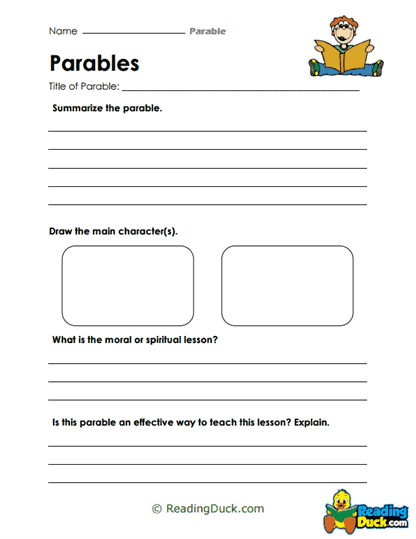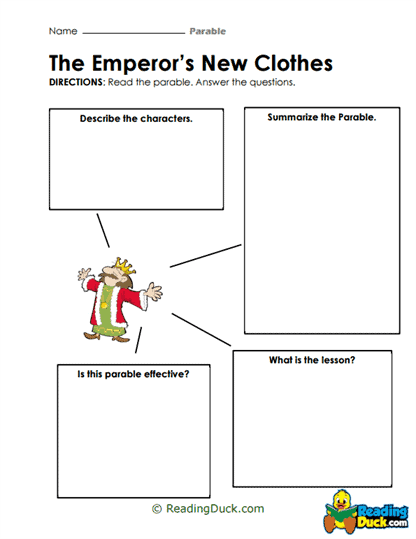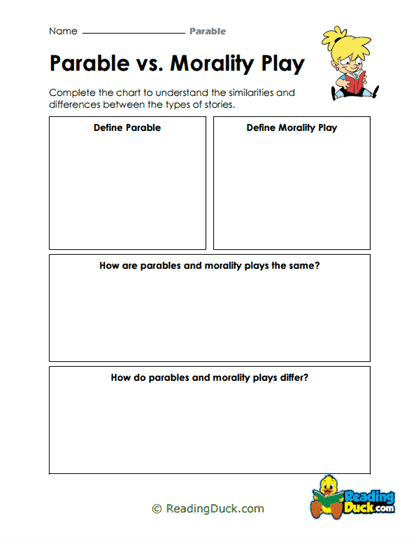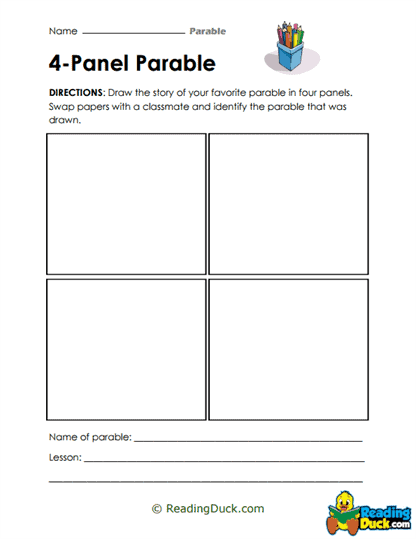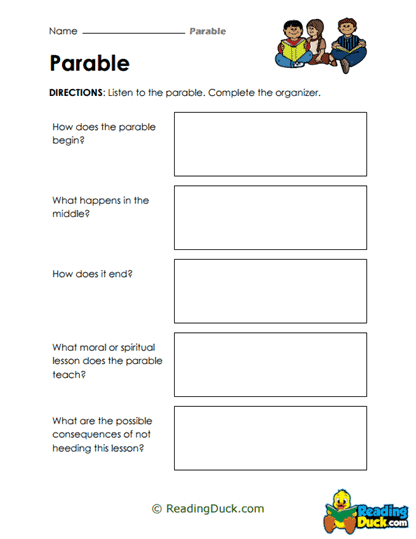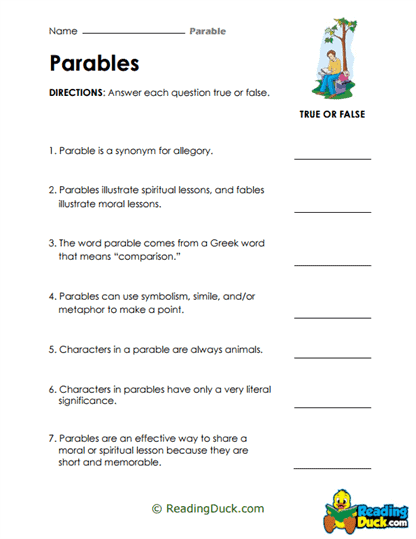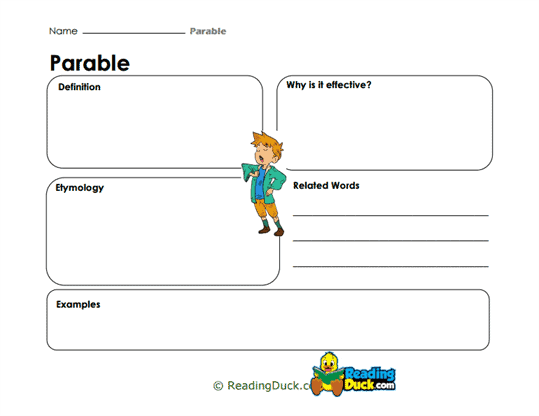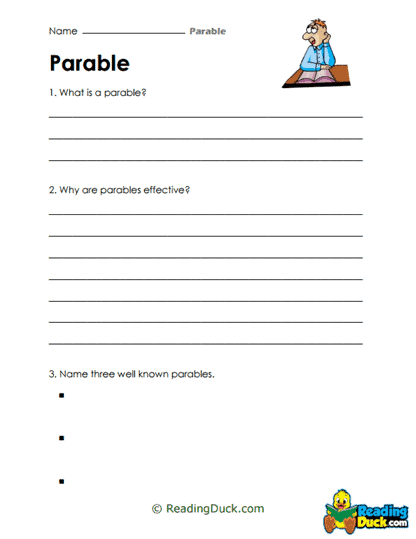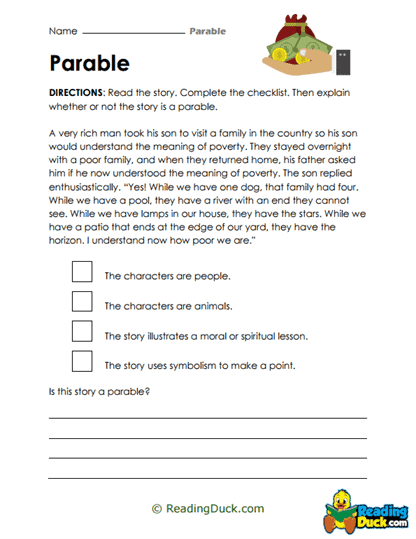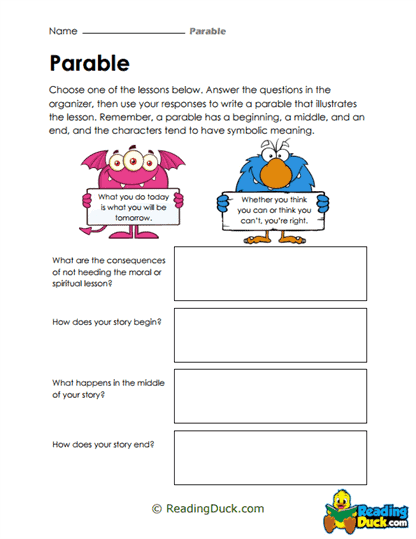Parable Worksheets
About Our Parable Worksheets
Our collection of Parable Worksheets, found under the Literary Devices category within the Skills section, is an excellent resource for students learning to understand and apply parables in literature. This collection helps students explore the key elements of parables, such as symbolism, allegory, and moral lessons, which are vital components in many literary works.
By engaging with these worksheets, students will develop their ability to identify and interpret parables, ultimately enriching their comprehension of deeper themes in various texts. These worksheets are available in PDF format, allowing for easy viewing, downloading, and printing. Additionally, each worksheet includes a downloadable answer key, making it simple for students and educators to assess their understanding and progress.
What is a Parable? A Complete Overview
A parable is a simple and short story used to convey a moral or spiritual lesson. Parables often employ familiar scenarios or relatable characters to communicate deeper truths about human nature, society, or life. They are typically easy to understand at the surface level, but their underlying messages encourage reflection and deeper thinking.
Defining a Parable
- Brief Story: A parable is usually concise, focusing on a single event or series of events that illustrate a broader lesson.
- Moral or Spiritual Lesson: The primary purpose of a parable is to teach a lesson, often related to morality, ethics, or spirituality.
- Universal Themes: Parables often address universal themes such as kindness, honesty, forgiveness, and justice, making them applicable across cultures and generations.
- Symbolism: Parables often rely on symbolism to represent larger concepts. For example, characters or events in a parable may symbolize broader human experiences or moral choices.
Structure of a Parable
Parables follow a specific structure that makes them easy to understand while delivering a significant lesson. This structure typically includes:
- Introduction: The parable begins by setting up a situation that is relatable or familiar to the audience. The characters and scenario are usually drawn from everyday life, making the story approachable.
- Conflict or Challenge: As the story progresses, a challenge or conflict is introduced. This central problem highlights the moral question or dilemma that the parable seeks to address.
- Resolution and Lesson: The story concludes with a resolution, often involving a clear moral lesson or reflection. The resolution invites the audience to think critically about the choices made by the characters and how those choices reflect broader ethical or spiritual principles.
Examples of Parables
- The Good Samaritan: In this famous parable, a man is beaten and left for dead on the side of the road. Several people pass by without helping, but a Samaritan stops to assist him. The parable teaches the importance of showing kindness and compassion to others, regardless of their background or social status.
- The Prodigal Son: This parable tells the story of a son who demands his inheritance and leaves home to live recklessly. After losing everything, he returns home, where his father welcomes him with open arms. The lesson of this parable centers on forgiveness, repentance, and unconditional love.
The Nature of Parables: Characteristics and Historical Significance
Parables have been a powerful storytelling tool for centuries, used across various cultures and religious traditions to teach moral and spiritual lessons. As a literary device, parables offer a unique way to convey complex ideas through simple narratives.
Key Characteristics of Parables
- Simplicity: Parables are intentionally simple in their language and structure, making them accessible to a wide audience. The simplicity allows the underlying lesson to shine through without getting lost in complex language or plot twists.
- Direct Moral Teaching: Unlike other forms of storytelling that might leave their messages open to interpretation, parables are often designed to deliver a clear moral or spiritual teaching. While the story itself may be symbolic, the message is usually straightforward and easily discernible.
- Use of Allegory: Parables often function as allegories, where the characters, events, or objects within the story represent larger ideas or values. This allegorical nature allows the story to work on two levels: the literal story and the symbolic lesson.
- Universality: The themes presented in parables are often universal, dealing with fundamental aspects of human life, such as integrity, generosity, and the consequences of one's actions. This universality makes parables relevant across time and cultures.
Historical Origins and Cultural Relevance
Parables have ancient origins, appearing in religious texts, folktales, and philosophical writings. Their use can be traced back to:
- Religious Texts: Parables are prominently featured in religious texts such as the Bible and the Quran. In these contexts, parables were used to impart spiritual wisdom and ethical teachings to followers. For example, Jesus frequently used parables in the New Testament to explain complex spiritual truths in a way that was accessible to his listeners.
- Fables and Folktales: Parables share similarities with fables and folktales, both of which use storytelling to convey moral lessons. While fables often feature animals as characters, parables typically focus on human experiences.
- Philosophical Literature: In philosophical texts, parables have been used to illustrate ethical dilemmas or explore philosophical concepts. The simplicity of parables makes them a useful tool for prompting reflection and discussion.
How Parables Contribute to Early Literacy Development
For young learners, studying parables is an effective way to build foundational literacy skills. The clear moral messages, simple structure, and symbolic content make parables an excellent resource for developing several key areas of early literacy.
Literacy Benefits of Studying Parables
- Reading Comprehension: Parables require students to read closely and interpret both the literal and symbolic meanings of the text. This dual-layered approach to reading fosters critical thinking and improves comprehension skills.
- Moral Reasoning: Parables often present ethical dilemmas or situations that require thoughtful consideration. Engaging with these stories helps students develop their own moral reasoning abilities, encouraging them to reflect on their values and actions.
- Vocabulary Development: While parables are simple in structure, they often introduce students to new vocabulary words or phrases related to moral and ethical concepts. This exposure helps expand a student’s vocabulary in a meaningful context.
- Writing and Storytelling Skills: When students are tasked with writing their own parables, they learn how to convey complex ideas in a simple, structured narrative. This practice sharpens their ability to organize their thoughts, create characters, and deliver a clear message through storytelling.
Engaging Activities to Reinforce Parable Learning
To make learning about parables interactive and enjoyable, educators can implement several creative activities that reinforce students' understanding of this literary device. These activities can be used in both traditional classrooms and homeschool environments.
Creative Parable-Based Activities
- Create Your Own Parable (Grades 4-8): Ask students to write their own parable, incorporating a moral lesson they believe is important. This activity encourages creativity while reinforcing the structural elements of a parable.
- Parable Dramatization (Grades 5-9): Have students work in groups to act out a well-known parable. This not only reinforces their understanding of the story’s lesson but also improves their communication and performance skills.
- Moral Discussion Circles (Grades 3-6): After reading a parable, lead a class discussion on the moral lesson. Encourage students to share their thoughts on how the lesson can be applied to real-life situations, fostering critical thinking and collaboration.
- Parable Comparisons (Grades 6-9): Assign students to compare two parables with similar themes, exploring how each story presents its moral lesson. This activity sharpens analytical skills and deepens their understanding of thematic connections.
- Parable Illustration (Grades 3-5): Younger students can illustrate a scene from a parable or create a visual representation of the moral lesson. This hands-on activity helps visual learners engage with the material.
The Value of Parables in Academic and Personal Growth
In summary, studying parables is an essential part of developing strong literary skills and moral understanding. Parables offer students a unique opportunity to explore ethical and spiritual lessons while honing their reading, writing, and analytical abilities. By learning to interpret parables, students gain insight into universal human experiences, making them more empathetic and reflective thinkers.
Academically, the skills acquired through the study of parables—such as comprehension, moral reasoning, and critical thinking—are crucial for success in literary analysis and writing. These skills are applicable beyond the classroom, helping students navigate complex moral decisions and think critically about the world around them.
On a personal level, the lessons imparted through parables can shape a student’s values and character. By reflecting on the ethical dilemmas and resolutions presented in parables, students can develop a stronger sense of empathy, integrity, and social responsibility.
This collection of Parable Worksheets provides a structured and engaging way for students to explore these timeless stories. Through the study and application of parables, students will not only become better readers and writers but also more thoughtful and compassionate individuals, prepared to contribute positively to their communities and society as a whole.
